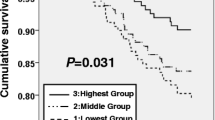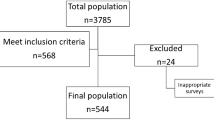Abstract
Objectives
The goal of the present study was to investigate the relationship between occlusal function and body composition in 108 premenopausal healthy Japanese women aged 20–45 years.
Methods
Pressure-sensitive sheets were used to measure occlusal function. Whole fat mass and lean mass, fat-free mass, and whole-bone mineral content were measured by dual-energy X-ray absorptiometry (DXA).
Results
After being adjusted for age and the square of height, the whole lean mass and grip strength of the large occlusal contact-area group were found to be significantly higher than those of the small occlusal area groups (p<0.05, respectively). In the 1-year follow-up study, changes in weight in the small-occlusal contact-area group and the low-occlusal force group were significantly larger than other occlusal-contact area or occlusal-force groups. The mean occlusal-contact area and occlusal force were both significantly smaller in subjects with partial dentures than in those without (p<0.05).
Conclusion
Large occlusal contact-area, high occlusal force, and no dentures may be associated with some good health conditions in premenopausal Japanese women.
Similar content being viewed by others
References
Garrett NR, Kaurich M, Perez P, Kapur KK. Masseter muscle activity in denture wearers with superior and poor masticatory performance. J. Prosthet. Dent. 1995; 74: 628–636.
Garrett NR, Perez P, Elbert C, Kapur KK. Effects of improvements of poorly fitting dentures and new dentures on masseter activity during chewing. J. Prostet. Dent. 1996; 76: 394–402.
Braun S, Bantleon HP, Hnat WP, Freudenthaler JW, Marcotte MR, Johnson BE. A study of bite force, part 1: Relationship to various physical characteristics. Angle Orthod. 1995; 65: 367–372.
Braun S, Hnat WP, Freudenthaler JW, Marcotte MR, Honigle K, Johnson BE. A study of maximum bite force during growth and development. Angle Orthod. 1996; 66: 261–264.
Krall EA, Garcia RI, Dawson-Hughes B. Increased risk of tooth loss is related to bone loss at the whole body, hip, and spine. Calcif. Tissue Int. 1996; 59: 433–437.
Bando K, Nitta H, Matsubara M, Ishikawa I. Bone mineral density in periodontally healthy and edentulous postmenopausal women. Ann. Periodontol. 1998; 3: 322–326.
Agerberg G, Carlson G. Chewing ability in relation to dental and general health. Acta Odontol. Scand. 1981; 39: 147–153.
Elders PJ, Habets LL, Netelenbos JC, van der Linden LW, van der Stelt PF. The relation between periodontitis and systemic bone mass in women between 46 and 55 years of age. J. Clin. Periodontol. 1992; 19: 492–496.
Klemetti E, Vainio P. Effect of bone mineral density in skeleton and mandible on extraction of teeth and clinical alveolar height. J. Prosthet. Dent. 1993; 70: 21–25.
Kuwano T, Takada H, Washino K, Inaba R, Yumoto Y, Iwata H. An evaluation of the biting force, the body composition and the amount of masticatory action in young females. Nippon Eiseigaku Zasshi 1998; 52: 624–630.
Waltimo A, Kononen M, Maximal bite force and its association with signs and symptoms of craniomandibular disorders in young Finnish non-patients. Acta Odontol. Scand. 1995; 53: 254–258.
Helkimo E, Carlsson GE, Helkimo M. Bite force and state of dentition. Acta Odontol. Scand. 1977; 35: 297–303.
Paphangkorakit J, Osborn JW. Effect of jaw opening on the direction and magnitude of human incisal bite forces. J. Dent. Res. 1997; 76: 561–567.
Proffit WR, Fields HW, Nixon WL. Occlusal forces in normal-and long-face adults. J. Dent. Res. 1983; 62: 566–570.
McDevitt WE, Warreth AA. Occlusal contacts in maximum intercuspation in normal dentitions. J. Oral Rehabil. 1997; 24: 725–734.
Garcia Cartagena A, Gonzalez Sequeros O, Garrido Garcia VC. Analysis of two methods for occlusal contact registration with the T-Scan system. J. Oral Rehabil. 1997; 24: 426–432.
Fukuda M. A new system for measuring occlusal force. Nippon Shishubyo-gakkai zasshi 1981; 23: 397–414.
Hidaka O, Iwasaki M, Saito M, Morimoto T. Influence of clenching intensity on bite force balance, occlusal contact area, and average bite pressure. J. Dent. Res. 1999; 78: 1336–1344.
Matsui Y, Ohno K, Michi K, Suzuki Y, Yamagata K. A computerized method for evaluating balance of occlusal load. J. Oral Rehabil. 1996; 23: 530–535.
Suzuki T, Kumagai H, Watanabe T, Uchida T, Nagao M. Evaluation of complete denture occlusal contacts using pressure-sensitive sheets. Int. J. Prosthodont. 1997; 10: 386–391.
Fujise T, Yoshimatsu H, kurokawa M, Oohara A, Kang M, Nakata M, Sakata T. Satiation and masticatory function modulated by brain histamine in rats. Proc. Soc. Exp. Biol. Med. 1998; 217: 228–234.
Smith SD. Adjusting mouthguards kinesiologically in professional football players. N.Y. State. Dent. J. 1982; 48: 298–301.
Gelb H, Mehta NR, Forgione AG. The relationship between jaw posture and muscular strength in sports dentistry: a reappraisal. Cranio 1996; 14: 320–325.
Miyahara T, Hagiya N, Ohyama T, Nakamura Y. Modulation of human soleus H reflex in association with voluntary clenching of the teeth. J. Neurophysiol. 1996; 76: 2033–2041.
Author information
Authors and Affiliations
Corresponding author
Rights and permissions
About this article
Cite this article
Hara, S., Yanagi, H., Amagai, H. et al. Occlusal function associated with body composition in premenopausal Japanese women. Environ Health Prev Med 6, 170–176 (2001). https://doi.org/10.1007/BF02897966
Received:
Accepted:
Issue Date:
DOI: https://doi.org/10.1007/BF02897966




